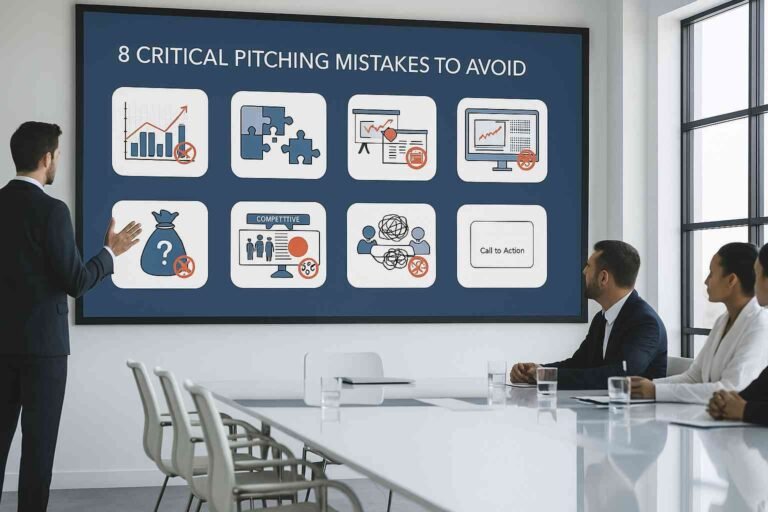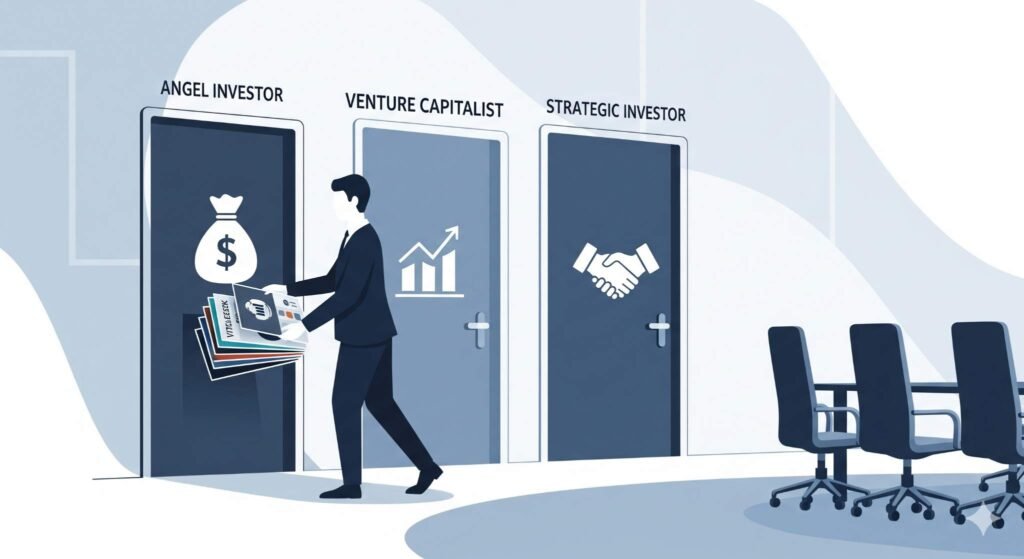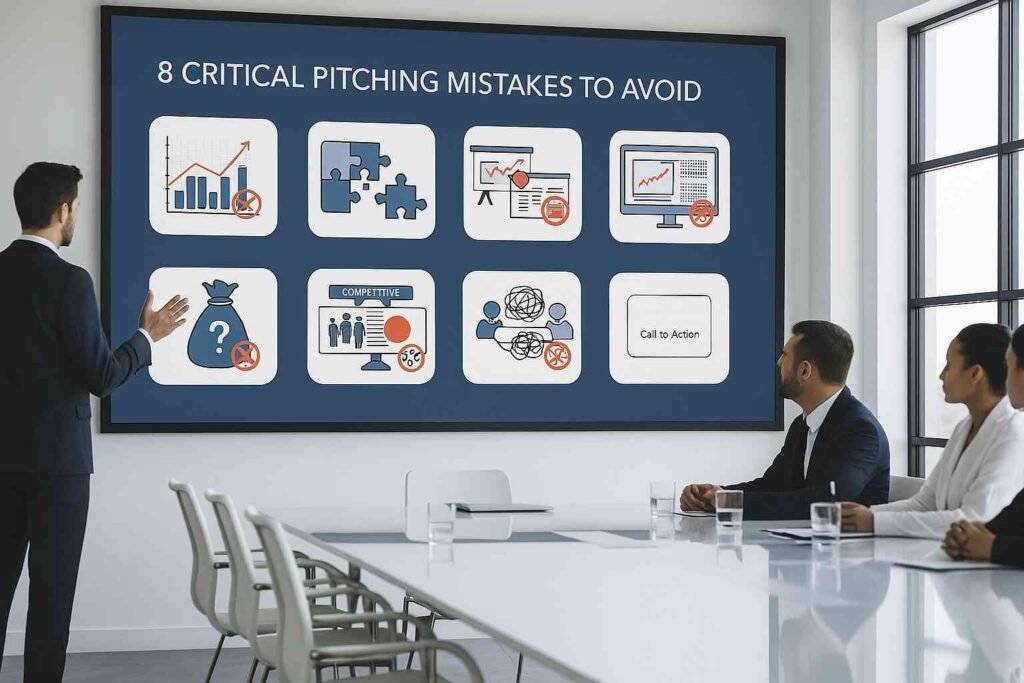Introduction
Making a pitch deck might sound scary, but it’s really just a way to tell your business story in a clear and simple way. It’s like showing a group of investors why your idea matters, how it works, and how they can earn from it. A good pitch deck can help you get that important first meeting, and if it’s done well, it can open the door to funding and partnerships. Whether you’re just starting out or trying to grow, this guide breaks down each part of a great pitch deck. We’ll walk you through the key sections step by step, so you can feel confident about building your own.
What Is a Pitch Deck?
A pitch deck is a short slideshow that tells people about your business idea. It usually has 10 to 20 slides and is used to talk to investors. You can show it at meetings or send it before demo events.
The goal is to:
- Tell your business story
- Show how the investor can earn money
- Do it all quickly, within 4 minutes
Why your business needs a pitch deck: Is It Important? Yes, a pitch deck is your chance to make a strong first impression. It should be simple but powerful, clear but interesting. It helps answer the basic question: “Why should someone invest in your business?”
The Basic Pitch Deck Format
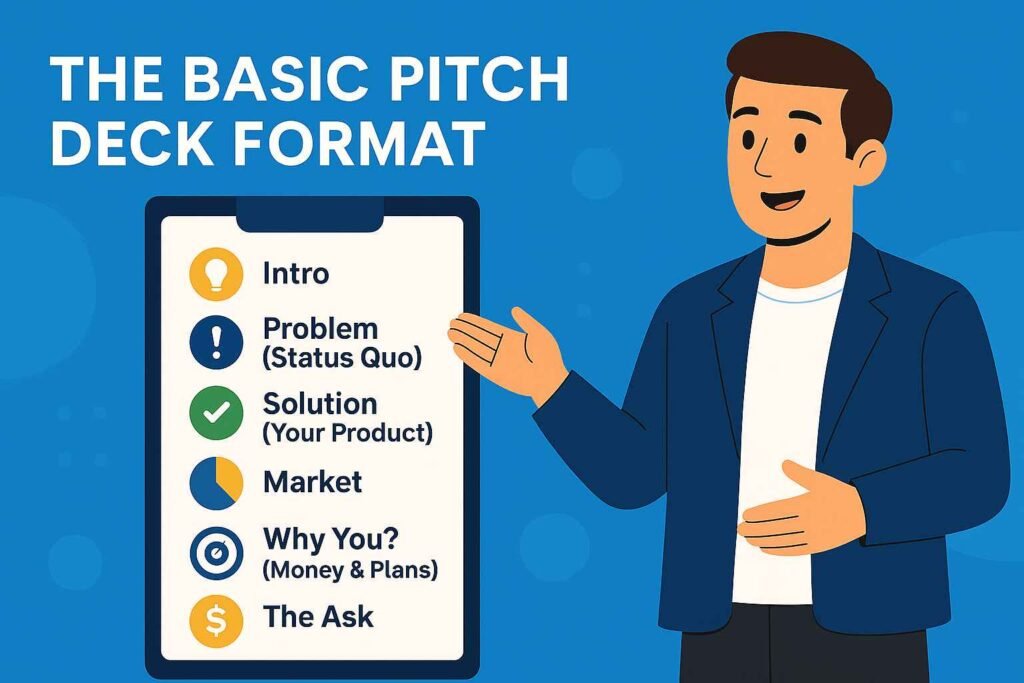
Every pitch deck usually has 6 parts:
- Intro
- Problem (Status Quo)
- Solution (Your Product)
- Market
- Why You?
- The Ask (Money & Plans)
Just like a story with a beginning, middle, and end, your pitch should:
- Start by catching attention
- Build interest using facts
- End with a strong reason to invest
The structure helps you stay focused and present your business in a logical way that’s easy to follow.
Company Stage: What Slides to Use
Depending on how new your company is, your deck may have fewer or more slides. You don’t need to include everything. Just focus on what’s most useful for your stage.
Here’s what you can include:
- Intro: Cover, Quick Wins
- Problem Area: What’s wrong? What’s the big chance?
- Product: What is it? Benefits? How it works?
- Market: Who will use it? Who else is doing this?
- Why You?: What makes you better?
- The Ask: How much money do you need? How will you use it?
If your business is very new, skip slides like financials or customer results. Focus more on the idea, the problem, and the plan.
Intro Section

Cover Slide: This is the first thing investors will see. Add your startup name and one simple line that tells what you do. Keep it short and clear. For example: “We help parents find safe babysitters fast.” This shows your purpose in just a few words and makes your deck feel professional.
Quick Wins: Show any early results that make your idea look strong. This could be things like the number of users, awards you’ve won, or partnerships you’ve made. It gives confidence to investors that others are already seeing value in what you’re doing. Even small wins can be powerful.
Problem: What’s Wrong Right Now?
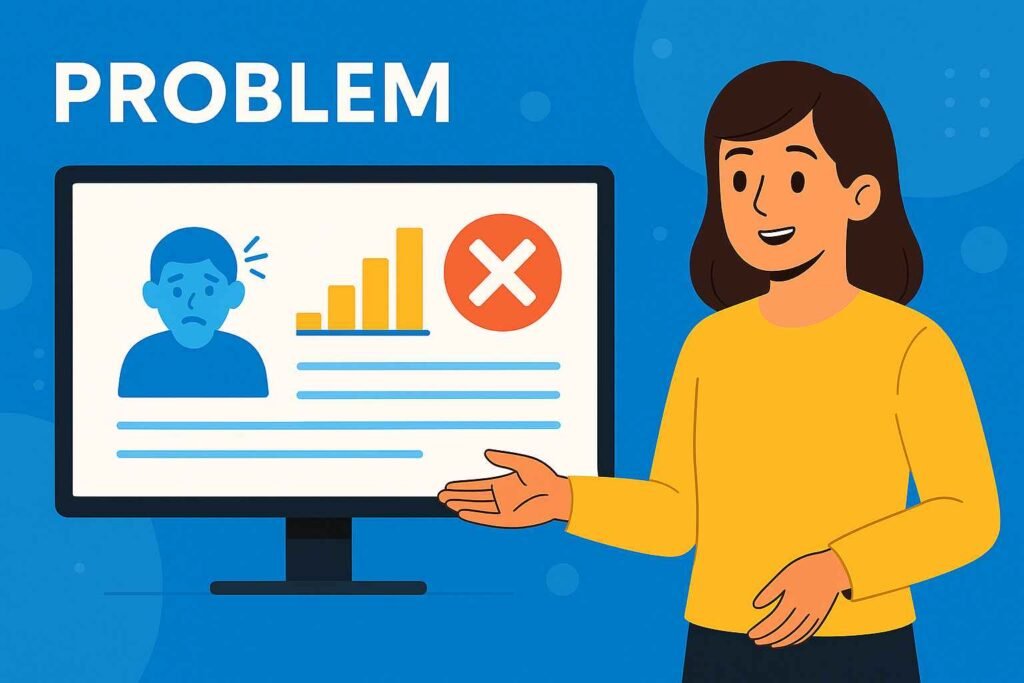
Start by explaining the main problem your product solves. Make sure it’s a real problem that many people face. Don’t use too much business talk—keep it simple and real so anyone can understand.
Use real-world examples, numbers, or short stories to make the problem feel big and urgent. If possible, explain how current solutions are not working well or are too costly. Make the investor feel like this is a serious issue that needs a better answer.
Solution: Your Big Idea

Now it’s time to show how your product or service fixes the problem you just explained. Describe your idea in plain language. Focus on the benefit your customer will get. For example: “Our app helps people find parking in 30 seconds.”
Avoid talking about features or technical terms. Instead, share what result or change your product brings. If your idea is unique or hard to copy, explain why. This helps the investor see that your solution stands out.
Product Section
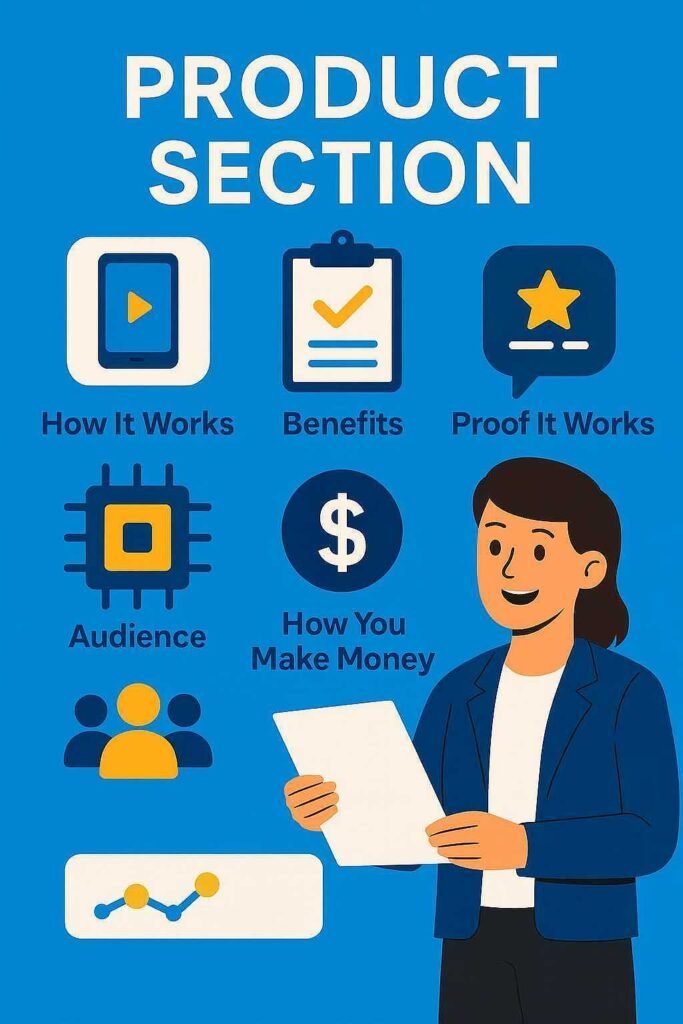
How It Works: Use simple words or pictures to explain how your product works. You could use screenshots, simple diagrams, or short videos. Try to make it visual so it’s easy to understand.
Benefits: Talk about what your product does for people. Don’t just list features—say how it helps. Example: “You can book a doctor in 2 clicks from your phone.” Think from the user’s view: what’s in it for them?
More Info: If your product uses smart technology or is a physical item, explain it clearly. Say what makes it smart or useful. Example: “We use smart sensors to track food freshness.”
Proof It Works: If anyone has used your product, talk about it. Share real feedback, reviews, or awards. This shows the idea is not just a dream—it’s already working.
Audience: Say who the product is for. Be specific. Example: “Busy parents in big cities.” Knowing your audience shows investors that you’ve done your homework.
How You Make Money: Keep it clear and simple. Say how you earn: is it a monthly fee? One-time price? Ad revenue? Example: “We charge $9/month for full access.” You don’t need a full breakdown, just the basics.
Your Plan (Roadmap): Show what you’ve done so far and what’s coming next. Use a timeline format. Example: “Launched app in Jan, added messaging in April, planning new feature in July.” This shows you’re thinking ahead.
Market Section

How Will You Grow? (Go-to-Market) Explain how you will get users or customers. Use simple examples:
- Running ads on social media
- Working with influencers
- Partnering with stores or apps
Only choose 2–3 main ways you plan to grow. That shows you have a focused plan and won’t waste time or money.
Market Size Investors want to know: how big can this business get? Share simple numbers. How many people need your product? How much money could be made?
Example: “10 million people need this kind of service each year.” This shows your idea has space to grow. If possible, include trusted sources for your numbers.
Why You? Section
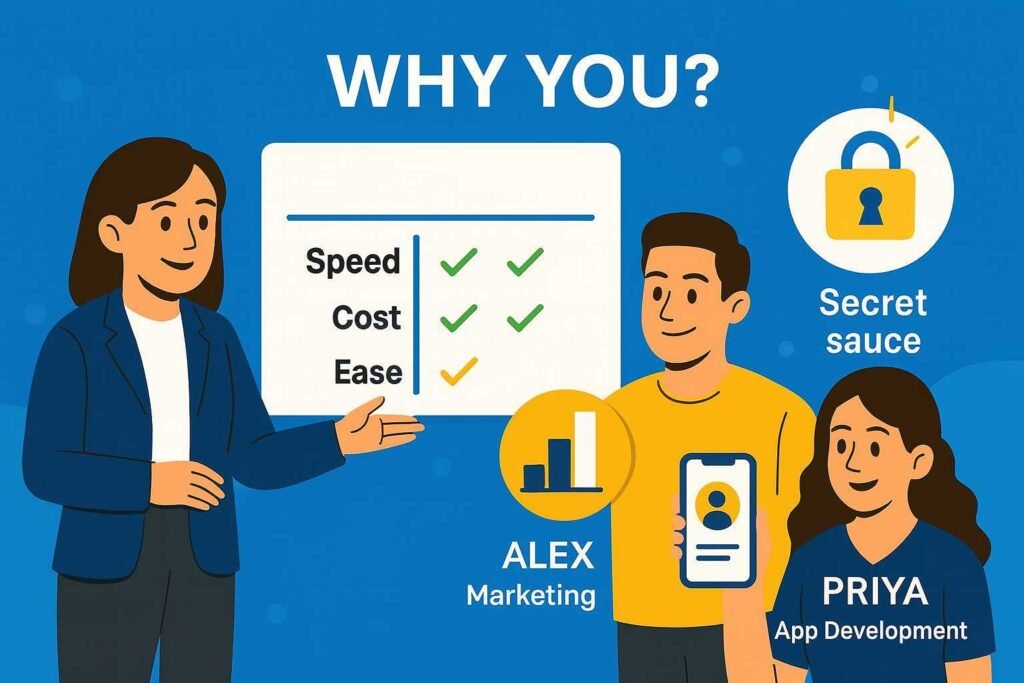
Who Else Is Doing This? Show that you know your competition. Name 2–3 other companies doing something similar. Then explain how you’re better.
Use a chart or list to compare. Example: “We are cheaper, faster, and easier to use.” This shows you’ve done your research.
Your Team Say who is building the company. Share their names, roles, and why they are the right people. Mention key skills or experience. Example:
- Alex: 5 years in marketing
- Priya: Expert app developer with 10+ apps
Investors want to trust that the team can actually do the work.
Your Special Edge (Secret Sauce) What makes your idea hard to copy? Maybe you have a special deal, technology, or a unique way of doing things. This is what makes you stand out from others. Investors love this because it means your business has a strong chance of staying ahead.
The Ask Section
Your Money Plan (Financials) If your business has made money, share it. Example: “$50K revenue last year.”
Then show basic plans for the next few years. You don’t need a long chart. Just say what you expect:
- Year 1: $100K
- Year 2: $250K
- Year 3: $500K
This shows you’re thinking long-term.
How Much You Want (The Ask) Clearly say how much money you are asking for. Example: “We want to raise $200K.” Then explain what the money will be used for:
- 50% marketing
- 30% hiring
- 20% tech updates
Investors want to know their money will be used wisely. Tell them what this funding helps you do—grow faster, reach more users, or build better features.
Final Tips
A great pitch deck is a short, strong story about your business.
Make sure each slide:
- Explains something important
- Is easy to read
- Helps build trust
Practice saying it out loud. Keep it short, clear, and confident. If you’re unsure, ask someone experienced to check your pitch. The goal is to show passion, preparation, and a clear plan. If you need help, you can also work with an investor pitch deck design service to guide you and make your slides stronger.
FAQs
1. How long should a pitch deck be?
Usually 10 to 15 slides. Enough to explain your business without too much detail.
2. Should I include financial projections if I’m just starting?
Yes, even rough numbers help. Keep it simple and honest.
3. What if I don’t have traction yet?
That’s okay. Show what you’ve planned, like tests, surveys, or prototypes.
4. Can I send a pitch deck before the meeting?
Yes, but keep it simple and save deep details for later.
5. What should I do after sending my pitch deck?
Follow up. Ask for a meeting. Be ready to answer questions.
6. Do I need a designer to make my deck?
Not always. Just make sure it’s clean and easy to read. Use tools like PowerPoint or Canva.
7. Can I get help building my pitch deck?
Yes! Many experts or consultants can guide you or check your slides.




